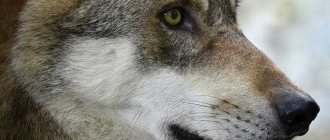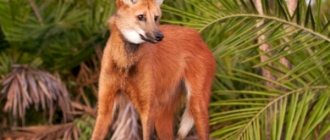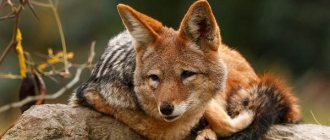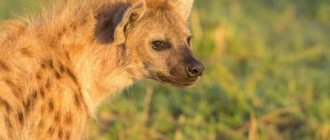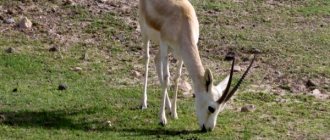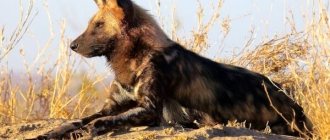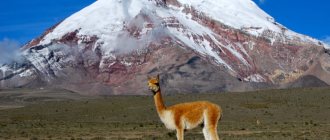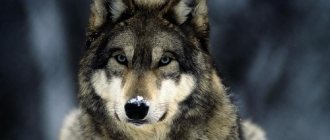Mackensian wolf
North America is an amazing continent. Many animals took refuge there, including the Mackensian representative. This type of wolf is often depicted in photographs with a bloody muzzle. Such an animal is considered one of the most bloodthirsty lowland hunters.
His massive body helps him kill animals quickly and without problems, or rather, a strong torso and long paws that can walk even in difficult areas. The respiratory system of this species is well developed. Even after walking 100 km, the Mackenzi wolf will not encounter the problem of shortness of breath.
The nose is a part of the animal’s body that is vulnerable to cold, therefore, during sleep, it often covers it with the hair of its long tail. This allows the animal to stay warm. The sternum of the Mackenzi wolf is covered with light hair, and the back and tail are darker.
This hunter always stalks the game with his brothers. Typically, in one group of Mackenzi wolves there are up to 10 individuals. Packs attack mainly large herbivores, such as moose or bison.
Red Wolf
This is a very rare species of wolf , found in the mountains of South and Central Asia. The individual is specific for its red fur. Some species of red wolves are endemic to specific areas. They have another name - “buanzu”.
The red wolf is very similar to the jackal and fox. This is a large and very fluffy predator. The animal's tail is so long that it has to be dragged along the ground. On the dorsal and caudal areas of the body you can see black fur, but there is little of it. Buanzu is born not red, but brown. As the wolf cub grows older, it brightens.
As the weather changes, the animal's fur changes. In summer it is quite rough, but in winter, on the contrary, it is gentle and soft. Also in the cold season, it becomes a little lighter. The appearance of the red wolf depends significantly on its habitat.
For example, individuals found in Indochina have the longest and softest fur, while “Pakistanis” and “Afghans” have short fur. An interesting feature of the species is the smallest number of teeth among all wolves.
polar Wolf
The home of this beautiful white wolf is the Arctic, which is why many zoologists also call it “Arctic”. The animal is not at all afraid of low temperatures; long, thick fur protects it from them. The animal's fur is so dense that it is not afraid of even cold rain and strong winds.
The biological reserves of food for this species in the Arctic are quite scarce. For this reason, when an animal kills its prey, it rarely leaves its meat “in reserve”; it completely tries to eat it. By the way, the polar wolf has established itself as an excellent hunter. A well-developed sense of smell and excellent eyesight help him in searching for prey.
It is known that due to lack of food, he can starve for 1 to 2 weeks. Why is this beautiful wolf at the stage of extinction? There are 2 reasons:
- The melting of Arctic glaciers, provoked by global warming on the planet.
- Increased attention of hunters to the snow-white fur of the wolf.
Marsupial wolf
Today, nowhere on Earth is the marsupial wolf found. This species is officially considered extinct. The body of such a creature reached more than 120 cm in length, and it weighed about 30 kg. It was found on the territory of modern Australia.
The appearance of the beast was more like a dog than a wolf. He had short but very thick fur. To the touch, it was quite rough. Stripes ran across the body of the marsupial wolf. In forest areas, such individuals chose caves as a sleeping place, and if they could not be found, then wooden hollows.
The marsupial wolf almost never united with other individuals to form packs. But there were known cases of these animals living in pairs. The beast's voice was very different from the voices made by other wolves. It was somewhat reminiscent of a cough, it was muffled and quiet.
Habitat
The maned wolf lives mainly in the south of America. It is most often found in an area that begins in the northeastern part of Brazil and extends to the east of Bolivia. In central Brazil it was seen in a deforested area. This rare animal can also be seen in Paraguay and the Brazilian state of Rio Grande do Sul.
In the pampas of Argentina it is preserved in small quantities. For life, the maned wolf chooses plains overgrown with tall grass and bushes. It feels comfortable in open forests, where it roosts in distant clearings or forest edges.
It can settle in a swamp, but stays near the edge, where there is a lot of vegetation, insects and small reptiles. Does not like heat and rainy weather; the optimal climate for it is moderate. Never settles in mountains, rocky terrain, sand dunes or dense forests.
dire wolf
Another extinct species of wolf. This is a huge animal, whose body reached more than 1.5 meters in length. And it weighed more than 60 kg. Its habitat was North America. The terrible one differed from the gray wolf in its larger body size and strong legs.
It was one of the main hunting objects of primitive people. It is difficult to say exactly who the dire wolves themselves hunted. However, there is an axiom in zoology - the body weight of a predator’s victim cannot be greater than the total weight of all members of the flock attacking it.
Based on this, we can conclude that during the life of the dire wolf, he attacked mainly bison, whose body weight exceeded 300 kg. But a flock of these strong animals could not feast on bison every day, so they often ate large aquatic mammals washed ashore.
Origin of the species and description
Photo: Gray Wolf
The common wolf or gray wolf (from the Latin Canis lupus) belongs to the canine family. Together with the coyote, jackal and a couple of other species, they make up the genus of wolves. During the study of their DNA, it was revealed that the animal is the direct ancestor of the domestic dog, while the second is considered a subspecies of the wolf.
The most likely ancestor of the animal is Canis lepophagus, a canid with a narrow skull that existed during the Miocene period. After the extinction of borophages, during evolution C. lepophagus grew in size and the skull expanded. Fossils found in North America likely belong to the ancestor of all modern wolves.
Video: Gray wolf
The first gray wolves began to appear during the Pleistocene era, about two million years ago. Among them was the species Canis priscolatrans, which later evolved into C. mosbachensis, which is very similar in appearance to today's common wolves. About 500 thousand years ago it evolved into Canis lupus.
During the Holocene period, the species settled in North America, where the dire wolf already lived. Due to the lack of large prey, the dire wolf became extinct about 8 thousand years ago. The appearance of the gray wolf caused competition for small and agile prey, which accelerated the extinction process.
Top Articles: Role of River Otters in Predicting Ecosystem Problems?
The species has 37 subspecies according to Mammal Species of the World and 38 according to the Joint Taxonomic Information Service, 13 of which are already extinct. Many populations were formerly considered separate subspecies but were later combined due to insufficient genetic differences.
Ethiopian wolf
The appearance of a wolf is most similar to a fox. This individual has a light red tint of fur; there is white delicate fur under the tail on the paws and the front of the neck. The ears of the animal are oblong and wide. It is endemic to Ethiopia, an endangered wolf species . This is not connected with hunting, but with a banal loss of genetic uniqueness, because this animal often crosses with African dogs.
The animal is very fast and agile. Long limbs help him gain impressive speed of movement. The Ethiopian wolf does not attack large game; it is only interested in small forest animals, such as hares, rats or mice. The largest animal that such a predator dares to attack is an antelope.
Lifestyle and nutrition
The wolf is a typical predator that obtains food by actively searching for and pursuing victims.
The basis of wolves' diet consists of ungulates: in the tundra - reindeer; in the forest zone - elk, deer, roe deer, wild boars; in the steppes and deserts - antelopes. Wolves also attack domestic animals (sheep, cows, horses), including dogs. They also catch, especially solitary wolves, smaller prey: hares, gophers, mouse-like rodents. In summer, wolves do not miss the opportunity to eat a clutch of eggs, chicks sitting on the nests or feeding on the ground of grouse, waterfowl and other birds. Domestic geese are also often caught. Foxes, raccoon dogs, and corsac dogs sometimes become prey for wolves; Occasionally, hungry wolves attack bears sleeping in a den. There are many known cases when they tore and ate weakened animals, wounded by hunters or seriously injured in a fight during the rutting season. Unlike many other predators, wolves often return to the uneaten remains of their prey, especially during the hungry season. They do not disdain the corpses of livestock, and on the sea coasts - the carcasses of seals and other sea animals washed ashore. During periods of starvation, wolves eat reptiles, frogs and even large insects (beetles, locusts). Wolves, especially in the southern regions, also eat plant foods - various berries, wild and garden fruits, even mushrooms. In the steppes, they often raid melon fields, watermelons and melons, satisfying not so much hunger as thirst, since they need regular, plentiful watering.
They are active mainly at night. Wolves often make their presence known with a loud howl, which differs greatly among mature males, female wolves and young animals. Of the external senses, the wolf has the best developed hearing, slightly worse - the sense of smell; vision is much weaker. Well-developed higher nervous activity in wolves is combined with strength, agility, speed and other physical characteristics that increase the chances of this predator in the struggle for existence. If necessary, the wolf reaches speeds of up to 55-60 km/h and is capable of traveling up to 60-80 km per night. And it accelerates to a gallop in a few seconds, covering 4 meters, after which it rushes at full speed.
When attacking a herd, wolves often kill several animals. Wolves keep uneaten meat in reserve.
Mentally, the wolf is highly developed. This is expressed in the ability to navigate the environment and avoid danger, as well as in hunting methods. There are known cases when a pack of wolves split up, and one part remained in ambush, while the other caught prey. In a pack chasing an elk or deer, often some wolves run on the heels of the victim, while others run across them or cowardly slowly and, having rested, replace the vanguard until they starve the victim out.
Cases of almost human intelligence in wolves have also been observed. For example, there was a case when hunters in a helicopter drove wolves into a grove. At first they could not be found, but then, when the hunters got off the helicopter and entered the grove on foot, it turned out that the wolves stood on their hind legs and (!) pressed themselves against the tree trunks, clasping them with their front paws, so it was extremely difficult to notice them from the helicopter difficult.
Opinions about the danger of a wolf to humans are very contradictory. Soviet and Russian zoologist M.P. Pavlov cites many facts of wolf attacks on humans. In a significant part of these cases, rabid animals attacked, but there are many cases of attacks by completely healthy wolves
Pavlov draws attention to the fact that in the territory of the former USSR the majority of such cases relate to several specific regions and concludes that wolves are aggressive towards humans mainly in places poor in natural prey. In such places, wolves are accustomed to feeding at the expense of humans and are less afraid of humans
V. M. Peskov in his book “Birds on Wires” also reports on wolf attacks on people, moreover, in the summer, during breeding, when wolves need food for their offspring (however, this fact is observed only at a high density of wolves). The high density of wolves is also dangerous because it creates conditions for rabies epizootics. At the same time, some Canadian and American researchers came to the conclusion that North American wolves are safe for humans. Canadian writer Farley Mowat, in his book “Don’t Cry Wolves!” states that wolves do not attack a researcher even when entering a den. However, there are reports of isolated cases of attacks on humans against wolves in North America.
Maned wolf
The animal received this nickname because of its long, delicate fur, reminiscent of the mane, not of a lion, but of a horse. Short fur is present only on the limbs of the individual. The maned wolf is found in several countries in South America, including Brazil.
The color of the animal's fur is red, but there are dark areas on the paws, neck and tail. The maned wolf prefers to settle in dense forest areas where there are tall plants. The main specific feature of this species is its long limbs. This is one of the few species of wolves that likes to hunt on its own, without its fellows.
The animal quietly sneaks through the thickets to silently get close to the prey, and then runs out sharply, attacking it. In addition to small animals, the maned wolf eats birds and fruits. Very rarely, it will team up with other wolves to attack livestock. Such an animal is classified as “family” (monogamous). It is interesting that the cubs of the maned wolf turn red over time. They are born brown or black.
Why do children watch bloggers?
Savely and Evgeniy have many children and teenagers among their subscribers. They actively watch entertaining videos and are fans of YouTube, TikTok or Instagram. Child neuropsychologist Larisa Golovina told us why children are so drawn to blogs.
She compares the desire of children to watch video blogs with the love of adults for TV series:
A blog is a certain predictable situation,” explains Larisa Golovina. “There will be the same character who performs the same actions. The same psychological mechanisms are at work here as in adults who watch TV series.
It's all about the heroic character that kids want to follow from video to video.
Neuropsychologist Larisa Golovina.
Publishing house "Altapress"
There is a character, and there is an emotional cast of the character that we build for ourselves. We somehow connect with this character. If a hero somewhere coincides with our experiences, with our inner picture, he finds a response from us. This is a willingness, a desire to share some emotions with the character. Basically, we do the same thing when we read books. “Always, at all times, seriality has been popular,” says the neuropsychologist.
Being a fanatical blogger always means a certain immaturity.
“An immature personality isolates in another personality what is significant for itself,” comments Larisa Golovina. “She creates a flat image, cutting off, for example, shortcomings and vices from the idol and attributing to him only some desirable and socially acceptable traits. It is not necessary that the individual will be the bearer of these traits. In children, immaturity is natural, normal, because their nervous system is immature, their psyche is still immature.”
Therefore, according to Larisa Golovina, blogs are more useful for teenagers than for young children.
The developmental opportunities of bloggers open up from adolescence, when communication with peers becomes the leading activity for a teenager. At every age there is a concept of its leading activity. It develops those basic psychological formations that are characteristic of age. Communication becomes the leading activity for a teenager. Then blogs play a developmental role. But for a child 5-10 years old, a gadget cannot have a developmental load, because he has activities for the development of a different nature.
Tundra wolf
Light long fur is what makes the tundra wolf stand out from other animals. Found in Russia. The size of the body is slightly inferior to the Arctic one. This species is also called Siberian.
To be completely satisfied, the animal must eat at least 10 kg of meat. But such luck is very rare for him. When the animal does not come across large game, it can feed on a rodent or hare.
In Siberia you can find a brown tundra wolf, but there are few of them; light ones are more common. This type of wolf in Russia is considered one of the most careful. The animal always avoids people.
Mongolian wolf
This type of canid is much smaller than the tundra one. The maximum weight of the Mongolian wolf is 38 kg. Light gray fur predominates on the body of the animal. They live in Russia, in the Primorsky Territory.
The Mongolian wolf is a very hardy animal. He can stalk his prey for several hours. The hunt of such predators often ends with their prey falling exhausted to the ground. Then the wolves pounce on her. The mechanism of their pursuit is interesting in that they slowly run after each other, in one long column.
Red wolf
Zoologists are still arguing about the classification of such an animal. Some believe that the red wolf is a species of gray wolf , while others believe that it is a separate type of canid. There is also a version that this predator is a hybrid of a coyote and an ordinary wolf.
Today this beast can be found in some American states, for example, in Texas. Their population is small, so the species is considered endangered. The animal's coat color is reddish-gray. But in Louisiana you can find darker representatives of this species. They have medium-length fur, long ears and strong slender paws.
In terms of habits and food preferences, the animal is no different from its “gray” brother. Just like the gray wolf, the red wolf prefers to live next to its relatives. However, such an animal does not create large groups. Each pack of red wolves includes no more than 8-10 individuals. This predator is monogamous.
While the pack goes hunting, the weakest wolf remains to look after the brood. By the way, red wolves feed mainly on raccoons and medium-sized rodents. Very rarely they manage to catch and eat large prey, such as elk.
Lifestyle of wolves
Wolves are nocturnal predators and their activity occurs in the dark. Forest animals live in packs, the size of which depends on the conditions of their natural habitat and the amount of food. On average, a wolf clan consists of 5-12 members, in rare cases their number can reach up to 25 individuals. Each flock occupies a personal territory, ranging from 50 to 1000 km2, and the size of their territory is determined by the region of habitat.
Usually, a wolf clan is formed from close relatives, but sometimes a pack decides to accept members of other families or lone wolves into its ranks.
Lifestyle of a wolf pack
Forest predators have a very complex social structure. There is a strict hierarchy in their team; each wolf has its own status and certain responsibilities. And at the same time, all members of the family observe the main rule - the interests of the pack are above all! In the wolf clan there is no place for personal desires, greed, greed and self-interest. The animals understand very well that their strength lies in unity and cohesion, so they strictly adhere to their laws.
The wolf pack has its own laws and rules
At the head of each pack is an alpha male, on whose shoulders lies responsibility for the well-being of the entire clan. It is the leader who makes all the key decisions regarding hunting, recreation, and declaring war on another clan. The alpha male has the right to expel or even kill the offending relative, and the fate of the incoming wolf depends on him - whether he will become a member of the family, or he will have to leave. In addition to his responsibilities, the leader also has some privileges, for example, he owns the best pieces of the spoils.
The alpha male is neither a tyrant nor a despot, but a wise and reasonable wolf who never abuses his unlimited power. He treats all members of his clan with equal friendliness, listens to their opinions, and in case of food shortage, shares his piece with young puppies, realizing that they are the future of the whole pack.
If the head of the pack has a female, then she occupies the next level of the hierarchy. The she-wolf dominates all females, and, if necessary, temporarily performs the duties of her spouse. The “First Lady” also keeps order in the clan and gives permission to other she-wolves to reproduce.
Recommended by topic
Ferret (ferret) Seagulls Pelicans
Many alpha males have successors who, after their death, become pack leaders. As a rule, this role goes to the leader's brother or his eldest son. A separate caste are adults, strong individuals of both sexes; they are the backbone of the military army, and are responsible for driving and capturing prey, and are also indispensable in battles with another pack. Female mothers are responsible for raising their offspring, and their task is also to monitor the safety of the cubs while the rest of the pack is hunting.
And finally, the most striking point that distinguishes wolves from all predators is that they take care of old or infirm wolves. Members of the clan who were injured while hunting or in battle with their fellow tribesmen, and wolves who reached old age, have the right to protection and food. True, when it comes to the survival of a flock, for example, during a famine or a raid by hunters, weak individuals become ballast. And according to the cruel wolf rules, useless family members are simply abandoned or, worst of all, sometimes even eaten.
Lone wolves
These animals have a very strong emotional attachment to their pack, so why do some animals prefer bitter loneliness? And the reasons can be completely different. Some wolves have strong leadership abilities, and since the place of the leader is unshakable, they voluntarily leave in order to eventually create their own clan.
Lone wolves have a hard time surviving in the wild
Sometimes, the wolf simply does not want to show unquestioning submission to the alpha male, and is forced to leave the pack, otherwise he will die for disobedience. Voluntary exile is also chosen by those predators who, for inexplicable reasons, are disliked by all members of the family, and demonstrate their contempt to him in every possible way.
In some cases, young males and females become lone wolves who do not want to join the pack, but prefer a life full of dangers, but free. Also, wolves who have lost their soulmate and now cannot find a suitable place for themselves in this cruel and merciless world can choose a solitary existence.
Character and habits
Most animals, whether predators or herbivores, live by primitive instincts: to eat, give birth, and survive on this not very hospitable planet. But wolves are extremely multifaceted and interesting creatures, with a deep inner world and a vulnerable soul.
Wolves do not tolerate betrayal and betrayal
Forest predators know how to love, remaining faithful to their partner until their last breath. They do not forgive betrayal and betrayal. Wolves know firsthand what friendship is, and value qualities such as loyalty and honesty in their relatives. These animals have courage, courage and nobility, and are ready to sacrifice their lives for the well-being of the entire pack. And finally, they are capable of such burning hatred that they will do anything for the sake of revenge, even certain death.
Already at a young age, the individual character of wolf cubs clearly manifests itself. Some of them are calm and reasonable, others have traits such as impudence and impatience, and still others have innate leadership abilities. And it is the wolf’s temperament that determines what rank he will occupy in the clan. These animals have an innate sense of belonging to the pack, they show loyalty to the leader and respect mature, as people say, “seasoned” wolves, who pass on all their experience to the younger generation.
Although forest predators have to constantly fight for survival, they find time for games and pranks. Not only young wolf cubs and juveniles love to play; adult wolves are also not averse to frolicking. After a successful hunt, when the entire clan has plenty of food, the animals arrange fun and noisy entertainment, which only strengthens friendly relations between members of the pack.
Wolves love to play and have fun.
Entire poems can be written about wolf love. Gray predators are monogamous, that is, they choose a partner for themselves for life, and the phrase “until death do us part” is not an empty phrase for these animals. Their family ties are not based on passion and the need for reproduction alone; a connection is formed between a pair of wolves at the highest mental level. As soon as animals meet their soulmate, they are no longer interested in other members of the opposite sex, and remain faithful to each other, both physically and spiritually.
There are many confirmed facts about how wolves remained near their partner who was caught in a trap or shot by hunters. Some predators are so attached to their chosen one that after his death they consciously go out to human settlements, as if they were looking for death and oblivion. Most wolves continue to live after the loss of their love, but they no longer enter into marriage relationships, preferring to remain alone forever.
And of course, one cannot fail to mention such a phenomenon as wolf revenge. These animals sometimes cause great harm to farmers, attacking villages and slaughtering livestock. Usually, this happens during harsh winters, when predators have to starve due to a catastrophic lack of game in the forests. But this is not the only reason. Sometimes wolves deliberately choose a populated area and cause real mayhem in it, indiscriminately killing everyone who meets them on the way. And all because the animals are taking revenge on the hunter living there, who killed their relatives or, even worse, newborn wolf cubs. The animals invisibly follow this man all the way to his house, and a few days later, under the cover of darkness, they sneak into the village to commit blood retribution.
Poll: Some people keep wolves as pets. Would you like such a pet?
Of course yes, I have always been fascinated by these beautiful and proud predators!
33.33%
Yes, it would be interesting to walk down the street with a real wolf.
16.67%
No, these are not domestic animals, but wild animals, they are unpredictable.
41.67%
No, I don’t like dogs at all, and especially wolves.
8.33%
Voted: 24
Eastern wolf
In zoology, there are a large number of versions regarding the classification of this canine species. According to the most common opinion, the eastern wolf is a hybrid of a red and gray wolf. This animal lives in the Canadian province of Ontario.
This predator is not one of the large ones. Its body measures up to 80 cm. It has a gray-yellow color. The animal's fur is very thick and dense. The eastern wolf is a social animal, but does not like to form large groups. One flock can contain no more than 3-5 individuals.
This type of predator is considered not only an excellent hunter, but also an excellent guard. If another animal wanders into the territory of the eastern wolf, it will certainly be attacked by all members of the pack. In deciduous forests, animals often hunt beavers and large mammals such as moose.
Features of behavior
The white wolf is a universal hunter. Such animals have an extremely acute sense of smell, excellent vision and hearing. Animals obtain food in packs. Each group member knows his task. Some wolves play the role of beaters, others - attackers. Following their prey, tundra wolves move in a single chain. Each individual tries to place its paws in the tracks left by the previous member of the pack. This behavior confuses inexperienced trackers, who think that only one animal passed along the existing path.
Tundra wolves gather in relatively small packs. The group usually includes an adult dominant pair, as well as young individuals from the previous litter. In some cases, you can see single animals from other packs here. The latter occupy a subordinate position in an unrelated group.
Life in the North is harsh. Flocks cannot feed many mouths. Therefore, in groups, only the dominant male and female produce offspring. For mating purposes, other adults usually leave the family and later form their own packs.
Melville wolf
The animal's habitat is the island of Greenland. The Melville wolf weighs no more than 45 kg, however, some individuals reach 70 kg. Gray and white Melville wolves can be found on the island of Greenland. Their fur is quite thick and long. The specificity of the species is small ears.
One individual will not be able to kill large prey, therefore, for this species there is a need for unification. Melville wolves hunt in groups of 6-9 individuals. Usually, animals track a herd of bulls or sheep, watch them and determine the weakest one.
The fact is that a strong, large animal can begin to resist and even attack the wolf in response. He knows this, therefore, he never fights with such people. Melville wolves spend the night in shallow rocky caves. The living conditions of such an animal are truly harsh. This is reflected in its numbers.
Dingo
Until now, biologists have not come to a consensus regarding the classification of dingoes. Some believe that the animal is a feral dog, in no way related to the wolf, while others believe that the dingo is a completely independent “wolf” species. One way or another, there is a version that he is a descendant of the Indian wolf, and a purebred one. Therefore, this animal is discussed in the article.
The species is widespread in Australia and Asia. Dingo is even found in New Guinea. It is a well-built, nocturnal predator with dense red fur. But the dingo also has white hair on its body (on the edge of the muzzle, tail and sternum). In New Guinea, there are also dark dingoes, with brown or even black fur.
Despite its "canine" nature, this type of animal never makes a sound reminiscent of a dog barking. But he howls by analogy with a wolf. This red animal settles near a pond. As a place to spend the night, dingoes choose large wooden hollows, holes or caves.
Interesting! Asian representatives of this species are not afraid of people, but, on the contrary, prefer to stay close to them. The fact is that people often feed dingoes. By the way, the red wolf-dog unites with its own kind, creating small groups. Only the leader and his female have the right to reproduce.
Reproduction
Puberty occurs in the guara or maned wolf in the second year, but offspring appear in 3-4 years of life. These animals are faithful partners - the female is fertilized by one male. Under natural conditions, the mating season lasts from April to June, in the northern regions from October to February. A female's estrus occurs once a year and lasts 4-5 days.
The gestation period for cubs is 62-66 days. In one litter, the female brings 2-4 puppies; in rare cases, 6-7 wolf cubs are born at once. Babies weigh 320-450 g. The mother usually arranges housing for newborns on small hills in dense thickets or in bushes on the edge of a swamp. In the wild, the male does not dig a shelter; care for the brood falls only on the female.
For the first 7-8 days, babies are blind, deaf and completely helpless, feeding only on mother's milk. Wolf cubs develop quickly. On the 9th day their eyes open, and after 3.5-4 weeks the drooping ears become vertical. After a month, they begin to eat what their mother regurgitates for them. Milk feeding lasts 13-15 weeks, after which they switch to solid food.
Initially, puppies are born with short, dark gray fur. Only the tip of the tail and the fur on the inside of the ears are white. At the age of 2.5 months, the hair begins to acquire a red color.
The first weeks of development of babies' paws remain short; in the 3rd month of life, the limbs quickly lengthen, with the lower leg and metatarsals intensively stretched. When the animal is one year old, the guara or maned wolf is already an adult predator, ready for independent life.
Central Russian forest wolf
This representative of predatory mammals is larger than the tundra wolf. The color of his dense fur is classic gray. The animal's sternum is lighter than its back. It has light fur. The average weight of a male Central Russian timber wolf is 40 kg.
This ferocious predator is found in the forests of Central Russia. In Altai you can meet huge Central Russian wolves, whose weight is even more than 70 kg. This is a very beautiful representative of its species, preferring to hunt, sleep and eat next to other individuals. The Central Russian wolf hunts large animals, for example, elk or deer.
In one group of such animals there are from 30 to 45 individuals. At one time, a female Central Russian wolf can give birth to up to 10 wolf cubs. She takes care of them, never losing sight of them. The male is responsible for searching for food.
Habitat
The habitat of this predator extends across the snow-covered expanses of the Arctic, with the permafrost soils of the Arctic tundra:
- Alaska
- Greenland
- North Canada
- Northern Asia.
The Arctic wolf prefers to avoid areas with a large area of icing, as there may be difficulties in obtaining food and making a den. The soil of the Arctic is practically barren. Only a few small plant species can grow here, limiting the diversity of herbivores. What does a polar wolf eat?
The main diet of this predator consists of large ungulates:
- muskox;
- reindeer;
- bighorn sheep;
- livestock.
Most often, a pack of predators stays close to a herd of ungulates, moving with it. A lone wolf cannot afford such prey. The pack approaches the hunting process in an organized manner. Predators identify their prey in advance, which is most often a young or old animal, sick or weakened.
The flock is divided into beaters and interceptors. The first ones drive the victim to the appointed place, where an ambush awaits him. Hunting for large animals is not always successful. Adult strong animals are able to protect young animals and are ready to fight off hungry predators. In some cases, persistence and the right tactics help the polar wolf break through the defense even from a dense ring of musk oxen. Sparse vegetation limits the number of herbivores. For this reason, the polar wolf is almost omnivorous. If he fails to catch large prey, he is content with small animals and birds:
- mouse-like rodents;
- polar hares;
- waterfowl and semi-aquatic birds;
- bird flights; small predators;
- beached marine mammals.
In one meal, a polar wolf can eat up to 10 kg of meat. He hides the remains of his prey and, if necessary, returns for it. The wolf does not disdain carrion and is capable of eating an individual of its own species if it is sick or injured. Nature has endowed the wolf with extraordinary endurance: it is able to live without food for up to two weeks, while remaining energetic and viable.
desert wolf
This species of wolf lives in Central Asian, Kazakhstan and Russian steppe and desert zones. There are grayish, red and gray-yellow individuals of the desert wolf. It is also called "steppe".
In terms of size, the strong animal is inferior to the gray wolf, however, it is just as strong and dexterous. A distinctive feature is quite hard fur. The body of the desert wolf is slender. This species has not yet been thoroughly studied.
Caucasian wolf
There is such an animal in Russia. In a pack of Caucasian wolves, there is a clear hierarchical division of individuals. The authority of the leader, the main wolf of the group, is only questioned if he is injured or old. Then another male can challenge him. Caucasian wolves are clearly aware of their belonging to a specific group.
They are intolerant of those animals that do not agree to live by their rules. “Caucasians” have a belligerent attitude towards other canines. If one of the predators dared to cross their territory, he would be in trouble. The pack attacks the beast. The fur color of the Caucasian wolf is white-gray. Their ears and paws are medium in size. There are small black hairs all over the body of the animal.
Despite their warlike and aggressive disposition, Caucasian wolves are quite sensitive to their brood. Both parents take part in the process of raising wolf cubs. They not only good-naturedly encourage them, but sometimes severely punish them. Usually the reason for punishing a wolf cub is his excessive curiosity.
Intragroup communication
In packs, tundra wolves make a wide variety of sounds. Scientists distinguish contact and distant methods of communication of such predators. The first group of conventional signs is used during close contact with relatives. This includes whining, snorting, growling, and squealing. Such sounds serve wolves to warn of danger, express feelings of aggression, fear or a friendly mood.
As for distant communication, it is worth noting various types of howls, with the help of which they give an alarm signal or warn strangers. Such sounds can be heard at distances of several kilometers.
Tundra wolves are also able to communicate using gestures. For example, flattened ears and sideways movements of the tail indicate the benevolence of the individual. A grin and raised hair on the back of the neck indicate aggression. When submitting to a stronger brother, the wolf lies on its back, revealing its vulnerable belly.
Siberian wolf
Some zoologists were skeptical about the need to classify the Siberian wolf as a separate species. In terms of coat color, size and behavior, these animals are very similar to their closest cousins, Central Russian wolves. They are widespread in Kamchatka, Transbaikalia and Siberia. The fur of such an animal is very soft to the touch, like silk. They are thick and long. The fur of the Siberian wolf is lighter than that of the Central Russian wolf. The weight of the animal is up to 45 kg.
Appearance and features
Photo: What a tundra wolf looks like
The tundra wolf is a fairly large predator; the average parameters for a male in the Arkhangelsk region are:
- body - 118-137 cm;
- tail – 42-52 cm;
- skull -25-27 cm;
- weight – 40-43 kg.
The female is characterized by the following indicators:
- body – 112-136 cm;
- tail – 41-49 cm;
- skull – 23.5-25.6 cm;
- weight – 36-37 kg.
In Taimyr there are larger individuals, whose body length is 123-146 cm and weight 46-48 kg; there are wolves up to 52 kg. The animal has thick and long hair. It feels soft and fluffy to the touch.
The lengths of the hairs are:
- guides - 15-16 cm;
- guard - 8-15 cm;
- underfur – 7 cm.
The tundra subspecies is much lighter in color than the forest subspecies, light gray with a reddish-gray underfur above and lead-gray below. Shades vary from bluish-gray (in young people) to reddish-gray (in old ones). Old individuals also have a lighter color. At the beginning of winter, the animals are darker in color, and in the spring they fade and become lighter. There are no almost white animals, as in the far north of North America. In coloration, animals from the Kola Peninsula and the extreme northeast of Siberia are more similar to their forest counterparts.
The feet are well covered with strong hair between the toes.
This increases the support area, which is important when moving on snow. Powerful paws are collected in a ball, the epithelium on the pads is keratinized
The forelimbs are rounded, the hind limbs are oval. When running, the hind paws step on the footprints of the front paws, and an even chain of footprints is visible in the snow. When the cover is deep, the flock follows exactly the same trail, so that it is impossible to understand how many animals have passed.
Iberian wolf
This is a very rare species of canine animal, which, until recently, was considered completely extinct. Lives in Spain and Portugal. The color of the animal's fur is reddish-gray. The Iberian wolf is much smaller than the Central Russian wolf. There are small white spots on its face, back and sternum. Because of this, the people called the beast “marked.”
Zoologists say that this type of wolf is very useful. The reason is to maintain the population of wood grouse, which in these parts are in danger of extinction. How does the Iberian wolf manage to do this? It's simple.
The animal hunts wild boar, which often pursues wood grouse. These animals hunt in small groups. Their prey is not only wild boars, but also roe deer, deer and sheep. Sometimes Iberian wolves eat fish.
Common jackal
This small animal is also called “bark san”. The jackal is found in South Asia, however, not so long ago, it was widespread in some European countries, for example, in Albania. The jackal is very similar to a dog. It's smaller than, say, a dingo, or even a standard mongrel.
Its body weight is much less than that of the gray wolf, up to 20 kg. The jackal's muzzle is pointed and oblong, like a fox's. The fur of this "reduced wolf" is brownish-gray in color. In winter it becomes smoother. During the day, Kora San almost never eats, choosing to eat in the evening. He eats:
- Fish;
- Bird;
- Carrion;
- Snails;
- Frogs;
- Bugs;
- Berries;
- Snakes, etc.
It turns out that the jackal is practically omnivorous. He rarely hunts with his own kind. Despite its small size and lack of wolf endurance, a sharp mind and dexterity help the jackal to be a good hunter. It can silently sneak up on its prey and easily grab it before it can escape.
Wolf: description
According to the conclusions of scientists who were able to establish that, at the genetic level, wolves are the ancient ancestors of domestic dogs. Dogs, in turn, are nothing more than a subspecies of wolves. Wolves are one of the largest and strongest representatives of this family.
Appearance
The weight and size of these animals can vary depending on living conditions. The height of this predator at the withers can range from 65 to 85 centimeters, and the body length reaches 100 – 155 centimeters, with a weight of 30 to 60 kilograms, and maybe more. A wolf, whose age is about a year, weighs on average 25 kilograms, and by the 3rd year of life they gain weight of about 40 kilograms. After 3 years of life, having gained weight of almost 55 kilograms, the wolf is considered “seasoned”.
In appearance, wolves are most similar to dogs, which have high and strong limbs, as well as larger, elongated paws. A pair of middle fingers are positioned slightly forward, so the wolf's footprint cannot be confused with the footprints of other animals. Wolves are distinguished by a broad-browed head and a massive muzzle, which is somewhat elongated forward. The muzzle is also somewhat expressive, which allows one to distinguish many facial expressions of the predator. The predator's skull is high, massive and large, and the nasal opening is large, expanding downward.
Interesting to know! The track of a wolf has significant differences from the track of a dog. Firstly, the side toes are set back more, and the paw seems to be kept in a ball. Secondly, the wolf has a more direct “path” left by the beast.
The wolf's tail is log-shaped and thick, always hanging down. Particular attention should be paid to the structure of the predator's teeth. On the upper jaw of the predator there are 6 incisors, a pair of canines, eight premolars and four molars, and on the lower jaw there are two more molars. The fangs of a predator play a very important role in the survival process as they help the predator to hunt by holding and dragging its prey. If a wolf loses its fangs, it may starve to death.
The wolf's coat is two-layered, thick and quite high. In addition, wool is quite tough and has water- and dirt-repellent properties. Thanks to the presence of thick undercoat, the wolf is not afraid of any cold. The color of individuals also depends on living conditions. Wolves living in forests are distinguished by a gray-brown tint, while predators living in the tundra are almost white. Predators inhabiting the desert are distinguished by a gray-reddish tint. At the same time, wolf cubs are characterized by monotonous colors and are darker and brighter, and as they grow and develop, the shades become lighter and duller. Even one population may consist of individuals whose color is more variable.
Behavior and lifestyle
As a rule, wolves are active in the dark, accompanying their hunt with a prolonged howl as a means of communication between their own kind. When a flock hunts or pursues prey, it tries not to make unnecessary, much less loud, sounds. During the daytime, like most predators, wolves stay in their shelters.
Interesting fact! Wolves can be found in various parts of the globe, which indicates that these predators easily adapt to any living conditions.
These predators have rather fine hearing, but their vision and sense of smell are slightly less developed. Wolves are distinguished by high endurance and quick reaction; in addition, they have high intellectual abilities, which allows them to survive in extreme conditions. Wolves are capable of chasing potential prey at speeds of up to 60 km/h, covering at least 100 kilometers per night.
Interesting facts - wolves
How long do wolves live?
Wolves live in their natural environment for at least 15 years, although this factor depends on many external interventions, especially humans.
Natural habitats
The habitat of wolves is very extensive, so the predator can be found both in Europe and Asia. In addition, wolves live within North America, in the taiga, in coniferous forests, in the icy tundra, and also in deserts. We can safely say that the northern boundaries of the habitat are represented by the Arctic Ocean, and the southern boundaries by Asia.
Due to the fact that people are actively introducing themselves into the natural environment, over the past few hundred years the distribution areas of wolves have become much smaller. People do not like such proximity, so they exterminate wolf packs and displace animals from their natural habitats. In this regard, there are no longer wolves in Japan, the British Isles, France, Holland, Belgium, Denmark and even Switzerland.
Interesting fact! Gray wolves are attached to their habitat, so they can occupy from 50 square kilometers to one and a half thousand square kilometers, depending on the characteristics of the landscape.
The area of territory occupied by a wolf family depends on the availability of food supply. In winter, wolves try to leave continuous forest areas where there is a lot of snow. The largest populations of wolves are observed in the tundra and forest-tundra, as well as in the forest-steppe and alpine zones, including the steppes. This predator can settle close to human habitation, and also inhabits areas that are subject to active deforestation, which is directly related to human activity.
Wolf diet
The basis of the wolves' diet is food of animal origin, although in the southern regions wolves can eat fruits and berries of wild plants. The diet is very wide and consists of wild animals, such as small rodents, hares, ungulates, both domestic and wild, birds and carrion. Living in the tundra, wolves hunt female deer, fawns, geese, lemmings and voles. Predators living in the mountains feed on mountain sheep, tarbagans, hares, etc. The following can serve as food for a wolf:
- Various pets, including dogs.
- Raccoon dogs.
- Various wild animals, including wild boars and roe deer.
- Various mammals.
- Bear, marten, fox.
- Caucasian black grouse and pheasants.
- Gophers and jerboas.
- Jerzy.
- All kinds of reptiles.
- Insects, especially large ones.
- Water rats.
- Various large fish.
- Some species of turtles and lizards.
- Small snakes.
Interesting to know! Wolves are considered one of the hardiest predators, since they can go without food for at least 2 weeks.
Wolves are quite intelligent animals, so they use different tactics for hunting, depending on various external factors. As a rule, wolves hunt in small packs, and each animal knows its duties.
Adults eat about 5 kg of meat per day, while the minimum diet consists of at least one and a half kg. If it was not possible to eat all the food, the wolves hide it securely.
Reproduction and offspring
Wolves are considered monogamous animals, so they form pairs to reproduce, regardless of the nature of the existing family. During the mating season, the behavior of both females and males changes towards aggressiveness, but after this period ends, the behavior of the flock becomes favorable for the growth and development of future offspring.
The female and male make their den in reliable shelters. Wolves often adapt abandoned burrows of other large animals for this purpose. The location of the den is such that the female and male sense the danger in advance.
The female carries her future offspring for 2 months. In territories with warmer climates, wolf cubs are born somewhere in late February or mid-April, and in territories with colder climates - in April-May. There can be from 3 to 12 wolf cubs in a litter. After birth, the female does not leave the babies for several days, so the male is responsible for feeding them.
For about a month and a half, the female feeds the future wolves with milk, and from the age of 2 months meat appears in their diet. When the wolf cubs get a little stronger, the female begins to participate in food production along with the pack, and the wolf cubs can remain alone for a long time. In case of danger, the female takes the wolf cubs to another, safer place.
Males can reproduce offspring as early as 2.5 years, and females a little earlier, although in fact, they begin to reproduce no earlier than at 3 years, or even 5 years. It should be noted that the first mating in a wolf pack depends on some external factors, including the food supply. As a rule, the number of wolves in a pack is regulated by the laws of natural regulation, which depend on various factors, including environmental factors.
Natural enemies of wolves
The gray wolf has practically no natural enemies, with the exception of humans, who thoughtlessly destroy many animals, including wolves. Therefore, we can safely say that only humans can influence the number of these animals, which are also called forest orderlies. The insufficient number of these forest orderlies often leads to outbreaks of various diseases among animals.
Population and species status
In some countries, populations of this predator were in danger of extinction, as people were very worried about the integrity of livestock. Therefore, wolves were not only poisoned, but also shot by hunters in large numbers. In this regard, for example, in the state of Minnesota, wolves have been under state protection for 40 years as an endangered species.
Countries such as Canada, Finland, Italy, Greece, as well as Alaska, including countries in Asia and the Middle East, can boast of a stable wolf population. In many countries, populations of this predator are declining due to the actions of poachers, as well as the displacement of wolves from their usual habitats. In countries such as Croatia, Macedonia, Czech Republic, China, Bhutan, Nepal and others, the wolf is under state protection. Some wolf populations are included in Appendix II of the CITES Convention.
